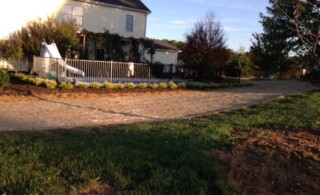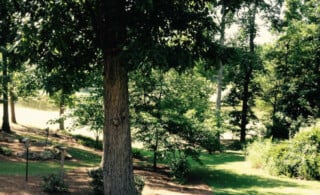 All you have to do to obtain a lush, green, and beautiful lawn that is the envy of all your neighbors is to keep it trimmed and water it on a regular basis, right? Unfortunately, it isn’t that easy. Once you have your turf established, fungi, lack of sunlight, pests, and even the beloved family dog can plague your lawn with dry spots, brown areas, and dead places that seem like they are almost impossible to get rid of. Here are eight common lawn problems, what causes them, and what you can to do overcome them to achieve a lawn that will be the talk of your street.
All you have to do to obtain a lush, green, and beautiful lawn that is the envy of all your neighbors is to keep it trimmed and water it on a regular basis, right? Unfortunately, it isn’t that easy. Once you have your turf established, fungi, lack of sunlight, pests, and even the beloved family dog can plague your lawn with dry spots, brown areas, and dead places that seem like they are almost impossible to get rid of. Here are eight common lawn problems, what causes them, and what you can to do overcome them to achieve a lawn that will be the talk of your street.
Problem: White Grubs
White grubs are pesky little critters that may be responsible for your lawn looking sparse in certain areas. You may have a white grub problem if you notice the following symptoms:
- Beetle larvae have started to feed on the roots of your grass
- Your lawn suffers the most in the fall
- The dead areas of your lawn roll away easily, like carpet
- Skunks, armadillos, and gophers make an appearance in your yard to feed on these grubs on a regular basis
If you think that white grubs are responsible for the dry and dead patches in your lawn, taking care of the problem is easy. All you have to do is apply an Imidacloprid at the end of spring or the beginning of summer to enjoy a beautiful lawn throughout the year.
Problem: Fungus Disease
Fungus isn’t just a problem that lurks in the gym bags and lockers of athletes; it’s also an issue that can cause serious issues with your lawn. Fungus may be taking over your lawn if you notice that dead spots appear in your yard almost overnight and expand at a rapid pace.
Luckily, most fungal diseases can be mitigated by adjusting your watering routines or fertilization methods. For example, you may find that your lawn becomes fungus-free if you water less or fertilize at different times of the day. If you think that applying a fungicide is your only remaining option, consult with a nurseryman in your area.
Problem: Sod Webworm
If dead spots pop up arbitrarily throughout your yard, your lawn may be infested by sod webworms. To confirm this diagnosis, soak a small patch of your lawn with a solution of soapy water. After about ten minutes, you should start to see these little worms come to the surface.
Getting rid of these little worms may take a little bit of effort. To start, aerate your lawn to reduce the amount of thatch and then apply a pesticide. If you’re not sure which pesticide to go with, Bacillus thuringiensis (Bt) has been known to be an effective way to control these worms.
Problem: Dog Damage
Although you love your dog, you might not love what it does to your lawn. If your dog has a favorite place to go to the bathroom outside on your lawn, this area may start to dry out thanks to its excrement. While it’s more difficult than it sounds, the best way to keep these small dry spots from taking over your lawn is to keep your dog away from them. Once you’ve done this, soak these areas with a hose on a regular basis and your lawn should get back to its uniform, green appearance in just a few weeks.
Ready to start your lawn problems?
Find ProsProblem: A Striped Lawn
Stripes are great on clothing and accessories, but they don’t make such a hot statement on your lawn. If you notice that your lawn has strips of dark green turf and other long strips that are yellow and dried out, this is a result of uneven fertilizer application.
To remedy the issue, the next time you’re out applying fertilizer, make sure that you are overlapping your tracks with the spreader. However, if these stripes appear to be more tan than yellow, the issue may reside with your lawn mower. Adjust your lawn mower to cut more evenly and you’ll likely find that the striping problem disappears over time. Investing in a professional lawn mowing is often an affordable way to get issues fixed and catch the ear of a professional who can advise on how to prevent future lawn problems.
Problem: Dry Spots
Dry spots occur when one area of your lawn dries out before other parts. Often, these patches are caused by:
- Compacted soil that prohibits grass roots from fully developing
- People walking repeatedly on your lawn
- A clogged or broken sprinkler system
To eradicate dry spots throughout your lawn, aerate it on an annual basis for $50 to $200. If this doesn’t help, watch your sprinklers when they run and adjust or repair them as necessary.
Problem: Thin Grass
Your lawn needs plenty of sunlight to survive. However, even in the shade, your grass should still be fairly dense. If you find that moss grows just fine in shady areas but your grass suffers, prune the trees or bushes — which could cost between $200 and $665 per tree — and aerate the space instead of watering it. If this doesn’t remedy the issue, you may need to switch to a different type of grass, like fine fescue, that is more tolerant of shade.
Problem: Chinch Bugs
Tiny insects, known as chinch bugs, suck the juice from blades of grass and cause spots that turn yellow and then eventually fade into a brownish color. If you have a St. Augustine lawn, you may be particularly at risk for a chinch bug infestation.
Like other lawn-infesting insects, it may take some time and effort to clear these critters away completely. Typically, aerating your lawn and applying an appropriately labelled pesticide can control their presence so that your lawn can thrive.
Remember, if you neglect your lawn during the spring or the fall and fail to figure out what may be causing the unsightly spots in your yard, you could end up paying for it for the rest of the year. Although identifying the exact cause of your lawn care woes and finding a solution that works may take a few cases of trial and error, it will be well worth it when you can confidently exclaim that your lawn is the best looking one in your neighborhood.
 Home Landscaping Resource Guide for Homeowners
Home Landscaping Resource Guide for Homeowners  Home Gardening Guide for Your Family
Home Gardening Guide for Your Family  Test Your Lawn Before You Fertilize
Test Your Lawn Before You Fertilize  How to Hire a Gardener for Your Lawn and Garden
How to Hire a Gardener for Your Lawn and Garden  What Should I Do With My Shade Trees After a Storm?
What Should I Do With My Shade Trees After a Storm? 

Could use more descriptive graphics & photos.
I Continually have the same problem every year the turf develops in a small area a silvery grey color then spreads quickly from there until its completely dies out from which it greens up again after some time